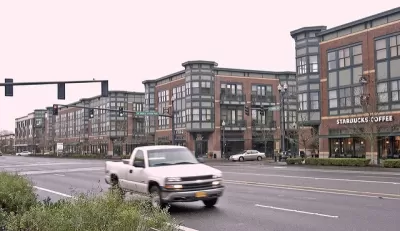Factors beyond political chance played into Oregon's recent decision to legalize missing middle housing. One key point: the state was already halfway there.

In an extended discussion of Oregon's recent history-making decision to effectively end single-family zoning, Joe Cortright highlights some of the policy trends that lie behind the bill. "It's critical to note that HB 2001 is built on a decades-long foundation of key state mandates and limitations on local discretion in the housing market," he writes.
Many of those policies are specific to Oregon, like the urban growth boundaries that surround its cities, indicating the lawful limits of development at an urban scale. "The less well known feature of the Oregon system is that the state also prescribes the kind of developments that local governments must allow within urban growth boundaries," Cortright continues.
Oregon's history of comprehensive land use planning at the state level goes back to 1973. But statewide prescriptions have really made a difference over the past ten years. "Over the past decade, three-quarters of all new housing units in metropolitan Portland were built on in-fill sites in already developed areas, or by redevelopment of existing built-up properties."
Cortright argues that Oregon's case makes a powerful argument for state governments to "force every jurisdiction to 'play fair' in the zoning game." But Oregon may also demonstrate the usefulness of policy precedent when it comes to statewide up-zonings. And that's a form of precedent that most states conspicuously lack.
FULL STORY: In Oregon: The middle isn’t missing any more

Planetizen Federal Action Tracker
A weekly monitor of how Trump’s orders and actions are impacting planners and planning in America.

Maui's Vacation Rental Debate Turns Ugly
Verbal attacks, misinformation campaigns and fistfights plague a high-stakes debate to convert thousands of vacation rentals into long-term housing.

Restaurant Patios Were a Pandemic Win — Why Were They so Hard to Keep?
Social distancing requirements and changes in travel patterns prompted cities to pilot new uses for street and sidewalk space. Then it got complicated.

In California Battle of Housing vs. Environment, Housing Just Won
A new state law significantly limits the power of CEQA, an environmental review law that served as a powerful tool for blocking new development.

Boulder Eliminates Parking Minimums Citywide
Officials estimate the cost of building a single underground parking space at up to $100,000.

Orange County, Florida Adopts Largest US “Sprawl Repair” Code
The ‘Orange Code’ seeks to rectify decades of sprawl-inducing, car-oriented development.
Urban Design for Planners 1: Software Tools
This six-course series explores essential urban design concepts using open source software and equips planners with the tools they need to participate fully in the urban design process.
Planning for Universal Design
Learn the tools for implementing Universal Design in planning regulations.
Heyer Gruel & Associates PA
JM Goldson LLC
Custer County Colorado
City of Camden Redevelopment Agency
City of Astoria
Transportation Research & Education Center (TREC) at Portland State University
Jefferson Parish Government
Camden Redevelopment Agency
City of Claremont





























